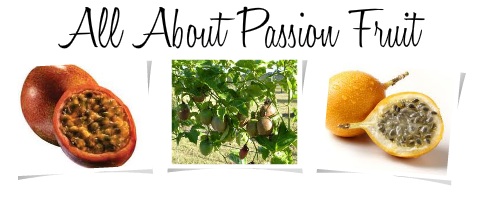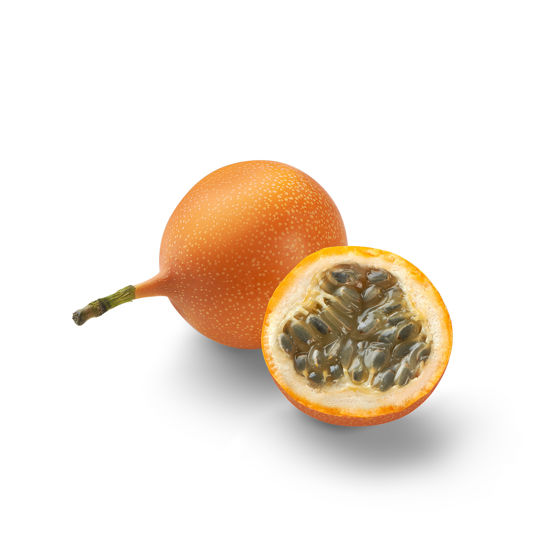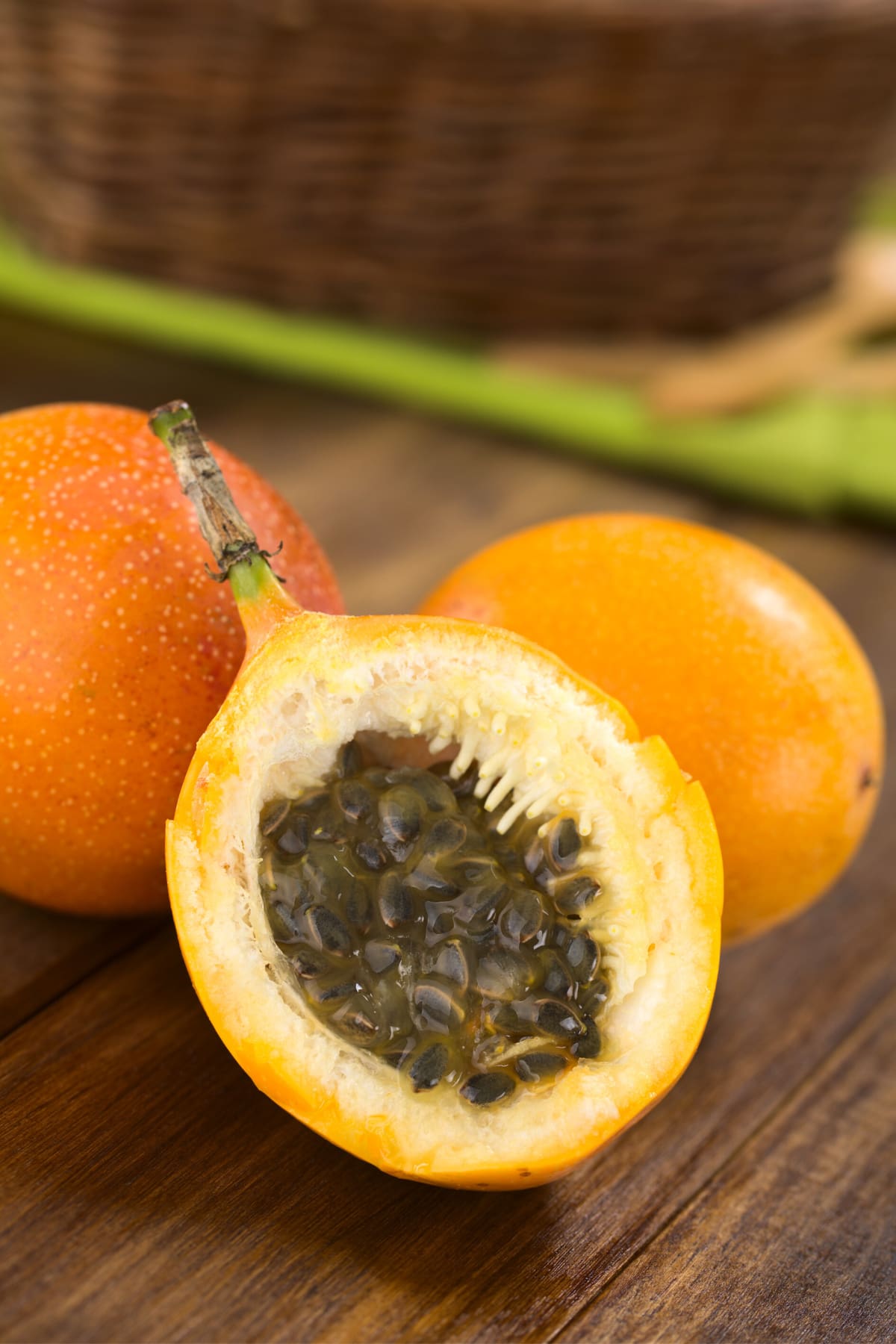Introduction

When it comes to exotic fruits, granadilla and passion fruit are often mistaken for each other due to their similar appearance and name. However, these tropical fruits have distinct characteristics that set them apart. This article aims to explore the differences and similarities between granadilla and passion fruit, including their taste, nutritional value, and health benefits. By understanding these aspects, readers can make an informed choice when incorporating these fruits into their diet. So, let’s delve into the world of granadilla and passion fruit and discover the unique qualities that make them stand out.
Overview Of Granadilla And Passion Fruit
Granadilla and passion fruit are two exotic fruits that belong to the passion fruit family. Although passion fruit is more well-known, granadilla is gaining recognition for its unique qualities. Granadilla is a round to oval fruit with orange, green, or yellow skin. It has a slightly sweeter taste compared to passion fruit. The hard shell of the granadilla is inedible. Passion fruit, on the other hand, has a wrinkled purple or yellow skin and a sweet-tart taste. Both fruits offer a range of health benefits and can be used in various culinary applications.
Health Benefits Of Consuming Exotic Fruits
Exotic fruits like granadilla and passion fruit offer a range of health benefits when incorporated into a balanced diet. These fruits are rich in vitamins, minerals, and antioxidants, which contribute to overall health and well-being. Consuming exotic fruits can boost the immune system, promote healthy digestion, and improve skin health. They are also known to have anti-inflammatory properties and may help in reducing the risk of chronic diseases such as heart disease and certain types of cancer. Including these fruits in your diet can provide a flavorful and nutritious addition to your daily routine.
Granadilla

Granadilla is a tropical fruit known for its unique appearance and delicious taste. It is round in shape and has a yellow or orange outer skin. The inside of the fruit is filled with a juicy pulp that is sweet and tangy, with a tropical flavor. Granadilla is rich in vitamins A and C, as well as dietary fiber, which promotes healthy digestion. It also contains antioxidants that help boost the immune system and protect against oxidative damage. Including granadilla in your diet can be a great way to enjoy a flavorful fruit while reaping its numerous health benefits.
Granadilla Appearance And Taste
Granadilla is a round to oval fruit that can be recognized by its orange, green, or yellow skin. The hard shell of the fruit is inedible and needs to be cracked open to reveal the juicy pulp inside. The pulp is filled with small edible seeds surrounded by a sweet and tangy yellow or orange flesh. Compared to the well-known passion fruit, granadilla has a slightly sweeter taste. Its unique flavor profile makes it a delightful choice for those seeking a tropical and refreshing treat.
Nutritional Value And Health Benefits Of Granadilla
Granadilla is not only delicious but also packed with essential nutrients. It is a good source of dietary fiber, vitamin C, and vitamin A. The fiber content aids in digestion and helps maintain a healthy digestive system. Vitamin C is an antioxidant that boosts the immune system and promotes collagen production for healthy skin. Vitamin A is crucial for good vision and supports the immune system. Furthermore, granadilla is low in calories and fat, making it a healthy option for weight management. Its high water content also helps to hydrate the body.
Passion Fruit

Passion Fruit is a tropical fruit known for its unique appearance and tangy flavor. It has a round or oval shape with a vibrant purple or yellow outer skin. The inside is filled with jelly-like pulp and edible black seeds. This fruit is rich in various nutrients, including vitamin C, fiber, and antioxidants. It offers several health benefits, such as boosting the immune system, promoting digestion, and protecting against chronic diseases. Passion Fruit is commonly used in various culinary creations, including beverages, desserts, and sauces. Its tangy and tropical taste adds a refreshing twist to any dish.
Passion Fruit Appearance And Taste
Passion Fruit, like Granadilla, has a distinct appearance and taste. It has a round or oval shape with a vibrant purple or yellow outer skin that is slightly wrinkled. The inside of the fruit is filled with jelly-like pulp and small, edible black seeds.
When it comes to taste, Passion Fruit is known for its tangy and tropical flavor. It has a sweet yet slightly tart taste that adds a refreshing twist to any dish. The combination of sweetness and acidity makes it a popular choice for desserts, beverages, and sauces. Its unique flavor profile sets it apart from other fruits and makes it a favorite among those seeking a vibrant and exotic taste experience.
Nutritional Value And Health Benefits Of Passion Fruit
Passion Fruit is not only delicious but also packed with essential nutrients. It is a good source of vitamins C and A, providing a significant boost to the immune system and promoting healthy skin. It is also rich in dietary fiber, promoting digestive health and preventing constipation. Additionally, Passion Fruit contains antioxidants, such as flavonoids and vitamin C, which help protect the body against free radicals and reduce the risk of chronic diseases. Regular consumption of Passion Fruit may also help lower blood pressure, improve heart health, and support eye health. So, including Passion Fruit in your diet can offer a wide range of health benefits.
Differences Between Granadilla And Passion Fruit

Granadilla and Passion Fruit may both belong to the same family, but they have distinct differences. Here are some key variations between the two exotic fruits:
- Physical differences and unique characteristics:
- Granadilla is larger in size compared to Passion Fruit.
- Granadilla has a thick, hard, and round shell, while Passion Fruit has a wrinkled and smaller shell.
- Granadilla has larger seeds compared to the smaller, black seeds found in Passion Fruit.
- Variations in taste and flavor profiles:
- Granadilla has a sweeter taste, ranging from tangy to overwhelmingly sweet, depending on ripeness.
- Passion Fruit has a sour taste, regardless of its ripeness.
These differences in appearance and flavor make Granadilla and Passion Fruit distinct choices for various culinary and taste preferences.
Physical Differences And Unique Characteristics
Granadilla and Passion Fruit exhibit distinct physical differences and unique characteristics. Granadilla is larger in size compared to Passion Fruit, and it has a thick, hard, and round shell. On the other hand, Passion Fruit has a smaller and wrinkled shell. Another noticeable difference lies in their seeds. Granadilla has larger seeds, while Passion Fruit has smaller, black seeds. These variations in appearance make it easy to differentiate between the two exotic fruits and add to their individuality and appeal in culinary creations.
Variations In Taste And Flavor Profiles
Granadilla and Passion Fruit have distinct variations in taste and flavor profiles. Granadilla is known for its subtly sweet taste, making it a favorite among those who prefer a milder flavor. Its flavor is often described as a combination of pear, melon, and citrus. On the other hand, Passion Fruit is renowned for its bold and tangy taste, with a delightful blend of sweetness and acidity. Its flavor is often likened to a mix of tropical fruits, including pineapple, mango, and citrus. These unique flavor profiles make both fruits a versatile and delicious addition to various culinary creations.
Similarities Between Granadilla And Passion Fruit

Both Granadilla and Passion Fruit share several similarities:
- Health benefits: Both fruits are rich in essential vitamins and minerals, including vitamin C, vitamin A, and dietary fiber. They are also known to have antioxidant properties, which can help boost the immune system and promote overall health.
- Culinary uses: Both fruits are widely used in various culinary applications. They can be used to make juices, smoothies, desserts, sauces, and even savory dishes.
- Tropical flavor: Both Granadilla and Passion Fruit have a distinct tropical flavor that adds a refreshing and exotic touch to any dish or beverage.
- Versatility: Both fruits can be enjoyed on their own or incorporated into a wide range of recipes, making them versatile ingredients in the kitchen.
In conclusion, while Granadilla and Passion Fruit may have some differences, they also share many similarities in terms of their health benefits, culinary uses, flavor, and versatility.
Shared Health Benefits
Both Granadilla and Passion Fruit offer several health benefits due to their rich nutrient content. Some of the shared health benefits include:
- High in vitamin C: Both fruits are excellent sources of vitamin C, which is essential for immune function, collagen production, and antioxidant protection.
- Rich in dietary fiber: Both fruits contain dietary fiber, which aids in digestion, promotes bowel regularity, and helps maintain a healthy weight.
- Antioxidant properties: Both Granadilla and Passion Fruit are packed with antioxidants, which help reduce oxidative stress, fight inflammation, and protect against chronic diseases.
- Good source of vitamin A: These fruits are also rich in vitamin A, which is important for vision health, immune function, and cell growth.
By incorporating Granadilla or Passion Fruit into your diet, you can enjoy these shared health benefits while adding a burst of flavor and tropical goodness to your meals and snacks.
Common Culinary Uses
Both Granadilla and Passion Fruit are versatile fruits when it comes to culinary uses. They can be enjoyed in various ways, including:
- Fresh consumption: Both fruits can be eaten fresh, either by scooping out the pulp or by cutting them in half and enjoying the sweet and tangy flavors.
- Juices and smoothies: Granadilla and Passion Fruit are commonly used to make refreshing and tropical fruit juices and smoothies.
- Desserts: The fruity and aromatic flavors of both fruits make them perfect for desserts like fruit salads, sorbets, ice creams, and cheesecakes.
- Sauces and dressings: The tanginess of Granadilla and Passion Fruit can add a unique touch to sauces, dressings, and marinades.
- Cocktails: These exotic fruits are often used as ingredients in tropical cocktails, adding a burst of flavor to drinks like margaritas and daiquiris.
By incorporating Granadilla and Passion Fruit into your culinary repertoire, you can elevate your dishes with their vibrant flavors and tropical essence.
Conclusion

In conclusion, Granadilla and Passion Fruit are both exotic fruits that offer unique flavors and health benefits. While Granadilla has a slightly sweeter taste and a gelatinous flesh with edible seeds, Passion Fruit has a tangy and tropical flavor with a similar texture. Both fruits are packed with nutrients and can be enjoyed in various culinary creations, including juices, smoothies, desserts, sauces, and cocktails. Whether you prefer the subtle sweetness of Granadilla or the zesty tang of Passion Fruit, incorporating these fruits into your diet can add a tropical twist to your meals.
Final Thoughts On Granadilla And Passion Fruit
In conclusion, Granadilla and Passion Fruit are both exotic fruits that offer unique flavors and health benefits. While Granadilla has a slightly sweeter taste and a gelatinous flesh with edible seeds, Passion Fruit has a tangy and tropical flavor with a similar texture. Both fruits are packed with nutrients and can be enjoyed in various culinary creations, including juices, smoothies, desserts, sauces, and cocktails. Whether you prefer the subtle sweetness of Granadilla or the zesty tang of Passion Fruit, incorporating these fruits into your diet can add a tropical twist to your meals.
Choosing The Right Exotic Fruit For Your Preferences And Needs
When it comes to choosing between Granadilla and Passion Fruit, it ultimately comes down to personal preference and individual needs. If you have a sweet tooth and enjoy a more tropical and flavorful taste, then Granadilla might be the perfect choice for you. On the other hand, if you prefer a tangier and more tart flavor, Passion Fruit might be the better option. Consider your desired taste profile, culinary uses, and health benefits when making your decision. Both fruits offer unique qualities and can be a delicious addition to your diet.
Frequently Asked Questions: Granadilla vs Passion Fruit
Q: What is the difference between granadilla and passion fruit?
A: Granadilla and passion fruit are two distinct tropical fruits that have a few notable differences.
Q: Are granadilla and passion fruit the same thing?
A: No, granadilla and passion fruit are not the same thing. They are two separate fruits, although they belong to the same family.
Q: Which fruit is sweeter, granadilla, or passion fruit?
A: In terms of sweetness, granadilla is generally sweeter than passion fruit. Granadillas have a sweet, honey-like flavor, while passion fruit has a balanced sweet-tart taste.
Q: What do granadillas and passion fruit look like?
A: Granadillas are typically round and larger than passion fruit, with a smooth, vibrant orange or yellow-colored skin. Passion fruit, on the other hand, is smaller and oval-shaped with a wrinkled, dark purple or yellow skin.
Q: Do granadillas and passion fruit have the same nutritional value?
A: Both granadillas and passion fruit are nutritious, but their specific nutrient profiles differ slightly. Granadillas are a good source of dietary fiber, vitamin C, and vitamin A. Passion fruit, meanwhile, contains more iron and vitamin E.
Q: Can I use granadilla and passion fruit interchangeably in recipes?
A: While they share some similarities, granadilla and passion fruit have distinct flavors, so using them interchangeably may affect the taste of your recipe. However, they can often be substituted for one another in recipes that call for their pulp or juice.
Q: Where are granadillas and passion fruit grown?
A: Granadillas and passion fruit are predominantly grown in tropical and subtropical regions worldwide. They are commonly found in South America (particularly in Brazil), Africa, and parts of Asia.
Q: How do I choose ripe granadillas and passion fruit?
A: When selecting ripe granadillas, look for fruits that are heavy for their size and have smooth, vibrant skin. Ripe passion fruit should have slightly wrinkled skin and give slightly when pressed.
Q: How do I eat granadillas and passion fruit?
A: To eat granadillas, cut the fruit in half and scoop out the jelly-like pulp, while avoiding the seeds or grit. With passion fruit, you can cut it in half and eat the pulp, including the seeds, or strain the juice to remove the seeds before consuming.
Q: Can I plant granadillas and passion fruit at home?
A: Yes, you can grow granadillas and passion fruit at home if you live in a suitable climate. They require a warm, sunny location and well-drained soil. Consult a gardening expert or reference specific planting guides for detailed instructions.
Nutritional Comparison: Granadilla vs Passion Fruit
Here’s a brief nutritional breakdown comparing these two fruits:
| Nutrient | Granadilla (per 100g) | Passion Fruit (per 100g) |
|---|---|---|
| Calories | 97 | 97 |
| Carbohydrates | 23g | 23g |
| Protein | 2g | 2g |
| Fat | 0.4g | 0.7g |
| Fiber | 10.4g | 10.4g |
| Vitamin C | 24mg | 30mg |
| Vitamin A | 566 IU | 1274 IU |
| Iron | 1.6mg | 1.6mg |
| Vitamin E | – | 1.9mg |

From At-Home Dinner Parties to Family Reunions to Office Parties, we can cater your next Event!